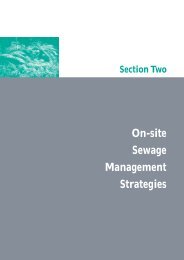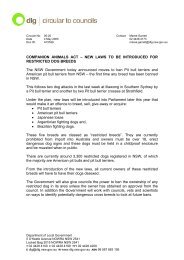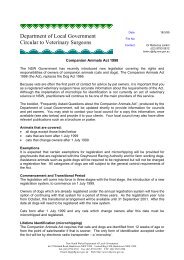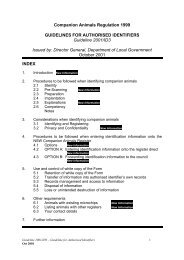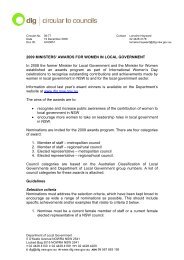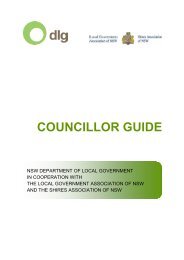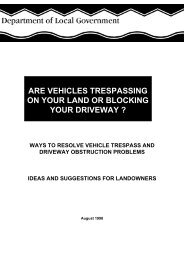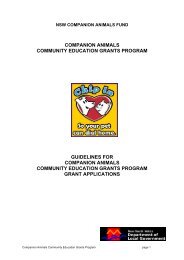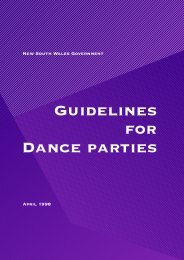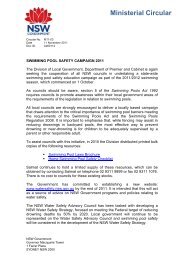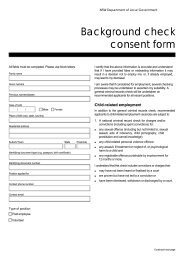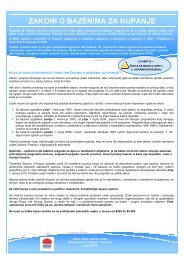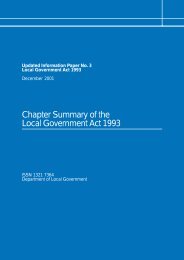Integrated Planning and Reporting Manual - Division of Local ...
Integrated Planning and Reporting Manual - Division of Local ...
Integrated Planning and Reporting Manual - Division of Local ...
You also want an ePaper? Increase the reach of your titles
YUMPU automatically turns print PDFs into web optimized ePapers that Google loves.
3. THE RESOURCING STRATEGY<br />
Key components <strong>of</strong> an asset management system<br />
The key components or tools in a council’s asset management system should include:<br />
Asset registers<br />
Asset condition assessments<br />
Asset maintenance <strong>and</strong> management systems<br />
Strategic planning capabilities<br />
Predictive modelling<br />
Deterioration modelling<br />
Risk analysis<br />
Lifecycle costing.<br />
Asset management decisions should be informed by evaluation <strong>of</strong> alternative means <strong>of</strong> service<br />
provision (eg asset sharing), full lifecycle costing, <strong>and</strong> performance measurement <strong>and</strong> monitoring.<br />
Informed decision-making recognises the long-lived character <strong>of</strong> infrastructure assets <strong>and</strong> the need<br />
to plan <strong>and</strong> budget for them on a full lifecycle basis beginning with the identification <strong>of</strong> a service<br />
need <strong>and</strong> the means to meet that need.<br />
The planning horizon<br />
Essential Element 2.11<br />
The Asset Management Strategy <strong>and</strong> Plan/s must be for a minimum timeframe <strong>of</strong> 10 years.<br />
The Asset Management Strategy <strong>and</strong> Plan/s will require three different but interlocking planning<br />
periods:<br />
A rolling 10-20+ years forecast, linked to the Community Strategic Plan <strong>and</strong> Long Term<br />
Financial Plan<br />
4 years to guide asset decisions flowing from the Delivery Program<br />
An annual plan detailing the actions to be implemented in the Operational Plan.<br />
As the Strategy is a ‘living document’ that will include benchmarks <strong>and</strong> milestones aimed at<br />
improving Council’s asset management processes <strong>and</strong> procedures, it must be monitored regularly<br />
<strong>and</strong> amended to reflect progression in its implementation.<br />
In addition, the Strategy <strong>and</strong> the Plan/s need to reflect any major changes in Council’s asset<br />
portfolio. These changes may reflect asset investments or disposals that have resulted from, or are<br />
reflected in, Council’s Delivery Program. Alternatively, these changes may result from unexpected<br />
major events, such as the decommissioning <strong>of</strong> a major asset due to severe storm damage or other<br />
natural disaster.<br />
Asset Management Plans should also be subject to ongoing monitoring <strong>and</strong> regular review (at least<br />
annually) to reflect any changes in asset conditions <strong>and</strong>/or the asset portfolio.<br />
With a 10 to 20+ year forward plan, elected members <strong>of</strong> Council <strong>and</strong> staff are in a better position to<br />
appreciate their current position <strong>and</strong> to be in a position to ensure any decisions take into account<br />
the impact on future generations. A council should not face any surprises in managing its assets.<br />
The relationship between long term financial planning <strong>and</strong> asset management planning is discussed<br />
further on page 5 <strong>of</strong> the Australian Infrastructure Financial Management Guidelines 2 (AIFMG).<br />
2<br />
Australian Infrastructure Financial Management Guidelines – Version 1.0, 2009<br />
<strong>Planning</strong> & <strong>Reporting</strong> <strong>Manual</strong> Page 68 <strong>of</strong> 115



